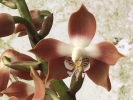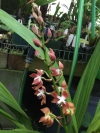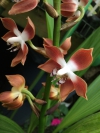|
|
|
|
|
| |
Flasks of
Neomoorea wallisii 'Emilia' HCC/AOS × sib 'Bill' |
|
| |
|
|
| |
| Number: |
TN9079 |
| Name: |
Neomoorea wallisii 'Emilia' HCC/AOS × sib 'Bill'
|
| Type: |
sib (What's that?) |
|
Seed Donor: |
Mr William Jasen
|
|
Click to Enlarge

Pod Parent |
Click to Enlarge

Pollen Parent Inflorescence |
Click to Enlarge

Pollen Parent Flowers |
|
|
|
| |
For additional origin/habitat information supplied courtesy of
Charles and Margaret Baker, see further below, near the bottom of this page.
|
Temperatures we attempt to use in the lab & greenhouse:
| For Species: |
|
Spring, Summer, Autumn, Winter: days average 76°F, nights 63°F; best fit is Cool-Intermediate 75-58°F
(Source:
Baker's Web OSC) |
|
About the name...
| Etymology of |
Neomoorea |
|
From Latin "neos", new; indicating a new genus named for F.W. Moore; English Botanist, curator at the Botanical Garden in Glasnevin, Scottland in the second half of the nineteenth century.
(Source:
Mayr & Schmucker 1998) |
| Etymology of |
wallisii |
|
Named for Gustav Wallis (1830-1878), German orchid collector, collected for Veitch in the northern parts of South America, one of the most famous orchid collectors of the 19th century.
(Source:
Hawkes 1978) |
| Pronunciation of |
Neomoorea |
|
nee-oh-MOOR-ee-ah
(Source:
Hawkes 1978) |
| Pronunciation of |
wallisii |
|
WAL-is-ee-eye
(Source:
Hawkes 1978) |
|
If you would like to direct someone to this web page, please copy and paste this URL into your email:
http://troymeyers.com/d?019079
| Flask Information |
| Availability: |
We have sold all of the flasks for this item. |
| You should: |
Consider getting individual plants or compots instead of a flask.
See if we have plants available in the greenhouse. |
| Yield Estimate: |
278 plants (based on flask surveys done 11/01/2022 through 10/06/2023)
|
| Plantlet Sizes: |
From many flasks 20 - 80 mm plants (based on flask surveys done 11/01/2022 through 05/05/2024)
From one most recently surveyed flask 70 - 80 mm (05/05/2024)
|
|
You might also want to:
|
View the seed assay for this item.
See if we have plants available in the greenhouse.
View items of the same species.
View items of the same genus.
|
| Ordering Information |
| You are not currently logged in. |
|
You must be a registered user and be logged in to reserve a flask or place a notification request. Please log in:
|
|
|
|
|
|
| |
The origin/habitat information below is supplied courtesy of Charles and Margaret Baker
The following information is based on the name of the plant provided by the donor, and assumes that the name is correct. If the plant has been misidentified, then the following information may not be correct.
This text is copyrighted by the Bakers and may not be reproduced without permission.
ORIGIN/HABITAT: Northern Colombia and Panama. Plants grow on trees or as
semiterrestrials on the surface of the ground in low-elevation forests.
Escobar (1991) reports that plants are found at 3300-5900 ft. (1000-1800
m). They were first collected in Colombia in the Department of Antioquia
and have since been found in a variety of other locations. In Panama, they
have been found along the Río Trinidad and near Lake Gatún. Habitat
location and elevation are not available for the Colombia collection
sites, but early writings reported that these fairly rare plants were
native to the temperate forests of Antioquia. Always uncommon, this
species is now reported to be very scarce in its natural habitat. Actual
habitat elevation is not known for certain, so the following temperatures
should be used somewhat cautiously.
More about this information and the Bakers...
|
|
|
| |
|
|
|